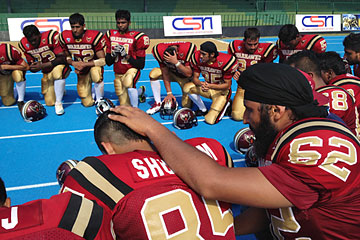
The Bangalore Warhawks' pregame prayer.
It's football season in India, and the music is thumping as the Delhi Defenders and the Pakistan Wolfpack prepare for kickoff. This is the first season of the Elite Football League of India (EFLI), and the match is being beamed by satellite to some 70 million homes across India. "This is a very potent Delhi squad. They should score a lot of points," the announcer predicts. Delhi would score three times, to win 21-0. "Today a new rivalry in a new sport is born."
So new, in fact, that this was only the third game anyone on the field had ever played. And yet this fledgling football league, showcasing players who have never played the game professionally to viewers who have never really watched it, sold the broadcast rights for the whole season to the satellite channel TEN Sports. The EFLI's founder, Sunday Zeller, and CEO, Richard Whelan, had just one notable sports venture behind them — the Orlando Predators of the Arena Football League — but the promise of tapping into India's huge potential fan base was enough to lure investors, including NFL Hall of Famer Mike Ditka. "With no TV, there's no money there," says Zeller. "Our focus was, We need the league in every home, every living room, in India."
The EFLI's fast start is the latest sign of the country's expanding appetite for televised sports. The number of Indian households with a television has almost doubled over the past decade, to 116 million in 2011, surpassing the 114 million U.S. homes with a TV. The market for advertising on Indian TV, meanwhile, is expected to double, to $4.4 billion, by 2015, and advertisers are desperate to reach viewers with any programming available — even gridiron football. The result is a mix that's part SportsCenter highlight reel and part reality TV. "That's the only way it's going to be successful," says Whelan. "If you want to make money in India, you have to make sports that are TV-worthy."
A Cure for Cricket Fatigue
The first of India's made-for-TV sports
was cricket — not the meandering, five-day-long matches between gentlemen in white but the Indian Premier League (IPL), which repackaged cricket as entertainment. It shortened the games and relied as much on star quality as quality play, selling several franchises to Bollywood stars. Before a single match was played, the league signed a 10-year, $1 billion broadcasting deal with Sony in 2008. "The IPL brought on a sea change in the perception of the business of sports," says Jamie Stewart, head of Commune Sports & Entertainment, a sports-marketing firm in New Delhi. "Suddenly people saw potential for sports as a business."
Broadcasters used that advertising base to expand into other sports. The audience for soccer, for example, almost doubled from 2008 to 2010, reaching 155 million, according to Mumbai-based TAM Media Research. The English Premier League consistently ranks second in weekly sports-TV ratings in India's cities. The cost of broadcast rights in South Asia for the soccer World Cup rose from $2.5 million for the 2002 Cup to $42 million for 2010. That cemented soccer's reputation as the best way to command an audience of young, affluent Indians, who are most likely to show signs of cricket fatigue and switch to another sport. "That's the generation that spends the most time watching TV and buying products," says Smita Jha, head of entertainment and media at PricewaterhouseCoopers India. "This is the same set of people whose incomes are rising, and this extra income is spent on leisure."
Who Needs Spectators?
If young Indians will watch english football, why not American football? Whelan figured that they care more about the entertainment value of a game than whether they grew up playing it. The EFLI set up five teams in India's biggest cities, as well as one in Pakistan and two in Sri Lanka, so it could sell regional broadcast rights.
